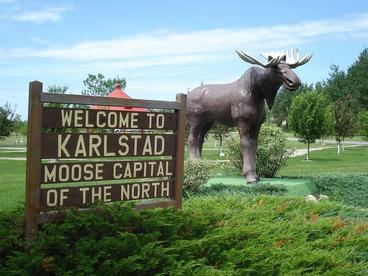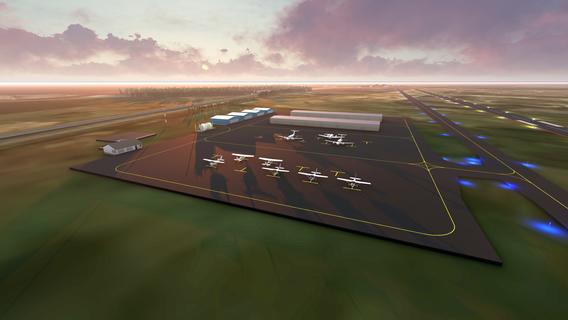
The Moose Capital of the North is gaining another title: Home of the First New Minnesota Airport in Almost 20 Years. The community of Karlstad, nestled 35 miles south of the US–Canadian border in the northwest corner of Minnesota, will still celebrate Moosefest each year. And don’t expect the bull moose silhouette on the town’s water tower to be replaced by an airplane any time soon. The town’s newest distinction, though, comes after years of planning and is expected to make a major impact on its 760 residents and the surrounding area.
“Karlstad’s community and businesses will really benefit from a new airport,” says Al Lundeen, chair of the airport board. “We’re excited about the increased job opportunities, economic development, and overall growth this will bring to the area.”
The City of Karlstad owns and operates the current Karlstad Municipal Airport, which was established in the mid-1950s and has a 2,606-ft. turf runway. The existing airport has struggled to meet the area’s aviation needs, in large part due to the runway’s seasonal sogginess as well as obstructions to navigation.
“The existing airport has several limitations for business use and growth, and it doesn’t support emergency medical services or firefighting either,” says Angela Holm, head of the aviation division at Bollig Engineering. Those issues have sent many crucial users to other regional airports over the decades. As a thriving community experiencing population and industry growth, the city knew something needed to be done, so the airport board began exploring options.
Improvements to the current location were ruled out as cost-prohibitive because of the runway’s condition, its inability to be lengthened, and obstructions in the approach and departure paths. With that decided, focus shifted to the possibility of relocating.
Prior to the planning of a new airport, MnDOT Aeronautics and the Minnesota Department of Employment and Economic Development (DEED) conducted extensive research into the current and future needs of the northwest region of Minnesota. Since 2017, the City of Karlstad and Bollig Engineering have worked together to summarize those findings, survey local businesses, and determine how to best serve the needs of Karlstad, the region, and the Minnesota State Aviation System.
No public hangars are available at the existing airport, and three aircraft are based in two privately owned hangars. Local pilots were surveyed and responded enthusiastically that they would increase their operations at Karlstad with an improved airport. The survey also confirmed that several additional aircraft owners would base their aircraft at the new Karlstad airport.
Beyond the benefits to recreational pilots, a new airport will provide better access to medical services, firefighting accessibility, and more convenient and agile business mobility. In particular, the business opportunities garnered attention during the research phase, as DEED projects that the northwest region of Minnesota will see a 4.2 percent increase in employment levels over the next decade. Research uncovered several businesses in the region interested in basing their aircraft at the new Karlstad airport.

Three prominent businesses—Mattracks Inc., Wikstrom Telephone Company, and GreenWay Environmental-Hydrovac—emphasized that expanded economic opportunities would be available to their businesses with new airport facilities. Mattracks is the world’s largest rubber track conversion manufacturer, selling to customers in 140 countries. It currently owns four aircraft, mostly based at other locations because of the lack of adequate facilities at the current Karlstad airport. Wikstrom Telephone is a large employer in the area and uses aircraft for consulting work. GreenWay Environmental provides services throughout the United States and uses aircraft for more efficient, convenient response and mobility.
MnDOT’s airport economic impact calculator estimates that having three business tenants at the Karlstad airport would increase annual economic activity by $1.9 million. In addition to expanded business opportunities, access to medical services will become more important as Kittson County, where Karlstad is located, is expecting its 65-and-older population to increase by approximately 40 percent over the next decade.
With all these factors at play, the City of Karlstad partnered with Bollig Engineering to conduct an airport feasibility report and site selection study funded by MnDOT. Based on the outcome, the city determined that a new airport would benefit local stakeholders well into the future.
The Minnesota Legislature, recognizing that the current airport was not conducive to supporting growth in the region, dedicated $5.6 million for the construction of a new airport in the transportation budget passed in late June 2021.
The new airport will be located less than two miles southeast of the city and will initially include a paved 4,000 ft. x 75 ft. lighted runway, an apron with 10 tiedowns, an AWOS, and a beacon. The future phases of the project will include lengthening the runway to 4,700 ft. x 100 ft. and adding fuel services, a parallel taxiway, an arrivals/departures building, a precision approach, and hangars to support multiple aircraft.
According to MnDOT’s economic impact calculator, airport construction alone will create 76 full-time direct and indirect jobs. The City of Karlstad believes the job numbers could be even higher.
“We’re really proud of the group effort our local leaders, state lawmakers, and the Bollig team put into making this project a reality,” Lundeen says. “This project is part of a bright future for Karlstad and we’re grateful it’s moving forward.”
Bollig Engineering is currently working on the initial phases of the project, which include environmental assessment, geotechnical testing, surveying, and preliminary design. Results of those efforts will inform the next steps, which include land acquisition and final design.
The anticipated completion date of the Karlstad airport is fall of 2024 or spring of 2025. As work begins, survey crews have been advised to be on the lookout for wildlife, but it’s not the town’s beloved moose they’ll watch for. Karlstad is also home to bears, although—thankfully—none have shown an interest in aviation yet.
—Angela Olson is a project coordinator/aviation planner with Bollig Inc.

